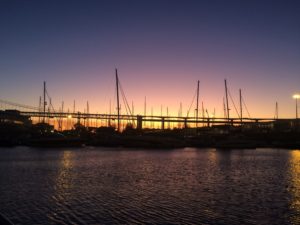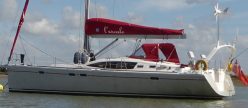Monday 7 – Tuesday 8 October
After all the touristing of the past couple of days, it was time to get back to the serious business of sailing. We set off South in the usual lack of morning breeze, and found ourselves in the midst of a huge pod of dolphin. Some were busy feeding, while half a dozen came and played around the boat and in the bow wave for some time. After three hours, around noon as usual, the wind filled in, from the Northwest as forecast, and we were able to set full main and gennaker, maintaining good speeds and trying to establish a watch pattern for this long passage.
By 1430 the wind had increased enough that it was time to furl the gennaker out of harm’s way, and set the genoa. Later in the afternoon we swapped the foresails over again, until dusk when the staysail was set up for the night. As it seems to suit us, Mate took the first long watch of the night, and when Skipper took over the deck in the early hours of the morning, we gybed to make the most of the now Northerly wind. Since the afternoon, we’d been within sight of another yacht often flying a red gennaker, sailing a little closer inshore, and we remained ‘sailing in company’ with them all the way to Lisbon. A Dutch-flagged yacht, Yndeleau’s skipper had spotted our peculiarly un-seamanlike wobble on the AIS trail during that gybe manoeuvre, and kindly called us to check all was well. The reassurance of knowing another yacht is with you on a long night sail was one of many special aspects of this passage.
The night was drizzly, damp and misty, the stars obliterated and shore lights invisible: a very dark night. Just before 0300 we cleared the absolutely Western-most point of mainland Europe, without fanfare nor yet another label of “finis terra”; this one’s simply called Cabo da Roca. Around dawn, Skipper gybed again to take us through the inshore passage between Cabo Carvoeiro and Ilha da Berlenga, while we lost ‘sight’ (on our AIS) of Yndeleau for a time as they followed the other two sides of the square. We were pleased to pick them up again, with occasional real sightings through the murky misty gloom, as we drew gradually nearer to Lisbon.
Having observed for some time breakers on an invisible shore, at 1615 the cry of ‘Land Ahoy!’ suddenly went up: we were only two and a half miles offshore. The sun finally broke through and the cloud burned off, revealing an attractive coastline fragrant with warm pine and eucalyptus. The wind strengthened to F6, with gusts of 35 knots and a big following sea, under the bank of fog to our stern. Our electronics recorded our top speed to date of 11.5 knots as we surfed down a wave. With speeds regularly around 9 knots, Mate was too busy steering to realise it was more than time to reef; fortunately Skipper was paying attention and set about reducing the main sail to second reef. Unfortunately the reefing pennant (rope) caught around the batten that shapes the top edge of the sail bag, and it tore away from the fabric by about half a metre…another job for Mate and the trusty sewing machine. We ended up with a very messy bag in the reefed sail, evidenced by an otherwise excellent set of photos from our companion ship, but it served to calm everything down to more manageable conditions, as we headed along the Barra Norte into the Rio Tejo for the capital city.
We bid farewell to our companions, who chose to anchor in the bay alongside Cascais marina, as we’d decided to ignore the encroaching dusk in a bid to make a sheltered marina well up-river. Amongst a plethora of yachts and catamarans, as well as tourist and commuter ferries, we managed to drop sails and motor under the huge Ponte de 25 Abril suspension bridge, which has a clearance of 70 metres, and carries both road and rail traffic. Skipper had chosen the Doca de Alcântara, one of four municipal marinas and the one with the best shelter from the wash and tidal flow of the river, as it is tucked behind a large commercial wharf. Finally out of the still strong wind, we gave up on the reception pontoon and tucked into a vacant berth alongside a sturdy pontoon. We completed 215 Miles in 35 hours: our highest average passage speed of just over six knots.

– if not the most peaceful
The pilot book states this marina is “a peaceful spot and the distant hum from bridge traffic is not a problem”. Hmmm, only if one is particularly hard of hearing: there is a constant harsh thrum from the bridge, the dock lies under the final approach flight path into Lisbon international airport, and behind a commercial dock busy with loading and unloading of large container vessels, supported by a mobile crane that crashes to and fro along the dock road. The usual city noises of sirens, revellers and traffic is but a background blur in comparison…but at least most of it quietens down overnight.
